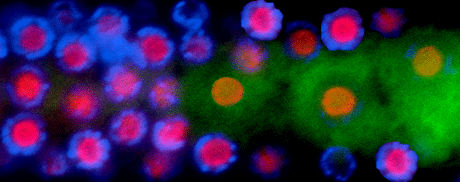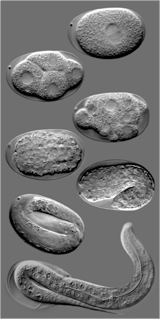DNA Damage

C. elegans germ line (blue), LIN-26 (red) and CEP-1::GFP (green)
Eukaryotic organisms preserve their genome integrity by exhibiting a properly regulated response when DNA is damaged. Lesions in DNA can be naturally occurring as the result of replication errors, oxidative damage by free radicals, endogenous alkylating species, meiotic recombination intermediates or spontaneous alterations in DNA. Otherwise, they might be caused by exogenous factors, such as ionizing radiation, UV light and chemical mutagens. The cells then activate surveillance mechanisms, called cell cycle checkpoints, with which cell cycle is arrested and DNA repair mechanisms are initiated. Failure for the lesions to be restored can lead to mutations or large-scale genomic instability. Because such changes may have tumorigenic potential, damaged cells are often eliminated via cell death (apoptosis). In our lab we are using the germline tissue of C. elegans to dissect the signaling network of the DNA damage responses. Our goal is to first define how evolutionarily conserved mechanisms are functioning in the worm and understand the fundamental processes triggered by ionizing radiation and UV light. We are examining the interplay between repair and apoptotic mechanisms, in combination with cell cycle kinetic studies to gain insight into how the mammalian system works. In order to identify new molecular components involved in this signaling network, we are performing forward genetic screens to isolate radiation-sensitive mutants. These might affect DNA repair and recombination processes, the chromosome behavior during meiosis and mitosis, as well as the general viability of the organism. Furthermore, we are interested in the molecular events underlying the primary response to chemotherapeutic agents. It has been established that the induction of apoptosis contributes to the therapeutic effect of many cancer drugs, whereas defects in this process can lead to drug resistance. We are, therefore, using signaling and apoptosis mutants to dissect the pathways used by cancer drugs to induce cell death. Finally, we aim to better understand the alterations in the transcriptional profile upon DNA damage. To detect genome-wide transcriptional responses as the biological outcome of genotoxic stress, we are using DNA microarrays. We subsequently do comparative studies to speculate on the genes’ placement into the damage signaling pathways. We believe that the outcome of our studies with C. elegans will expand the current knowledge on DNA damage responses, resolving the complexities of the mammalian network and revealing the link between defective responses to DNA damage and human diseases.
Sendoel A, Maida S, Zheng X, Teo Y, Stergiou L, Rossi CA, Subasic D, Pinto SM, Kinchen JM, Shi M, Boettcher S, Meyer JN, Manz MG, Bano D, Hengartner MO. DEPDC1/LET-99 participates in an evolutionarily conserved pathway for anti-tubulin drug-induced apoptosis. Nat Cell Biol. 2014 Aug;16:812-20.
Eberhard R, Stergiou L, Hofmann ER, Hofmann J, Haenni S, Teo Y, Furger A, Hengartner MO. Ribosome synthesis and MAPK activity modulate ionizing radiation-induced germ cell apoptosis in Caenorhabditis elegans. PLoS Genet. 2013 Nov;9(11):e1003943.
Kratz K, Schöpf B, Kaden S, Sendoel A, Eberhard R, Lademann C, Cannavó E, Sartori AA, Hengartner MO, Jiricny J:Deficiency of FANCD2-associated nuclease KIAA1018/FAN1 sensitizes cells to interstrand crosslinking agents. Cell 2010, 142: 77-88.
Sendoel A, Kohler I, Fellmann C, Lowe SW, Hengartner MO :HIF-1 antagonizes p53-mediated apoptosis through a secreted neuronal tyrosinase. Nature 2010, 465: 577-83.
Zermati Y, Mouhamad S, Stergiou L, Besse B, Galluzzi L, Boehrer S, Pauleau AL, Rosselli F, D'Amelio M, Amendola R, Castedo M, Hengartner M, Soria JC, Cecconi F, Kroemer G: Nonapoptotic role for Apaf-1 in the DNA damage checkpoint. Mol Cell 2007, 28:624-637.
Schumacher B, Hanazawa M, Lee MH, Nayak S, Volkmann K, Hofmann R, Hengartner MO, Schedl T, Gartner A: Translational repression of C. elegans p53 by GLD-1 regulates DNA damage-induced apoptosis. Cell 2005, 120:357-368.
